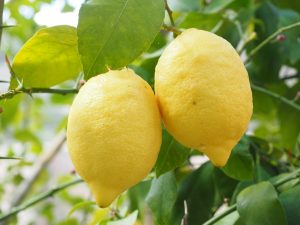Lemon trees are subtropical trees cultivated for their sourly delicious fruit. Lemons have several applications, not only in cooking but also in the household and in medicine!
An oversupply of lemons should not be feared because they can be preserved and saved later.
This article will walk you through planting, seedling, germination, development, blooming, fruiting, harvesting, and drying lemon trees.
How Does It Take For A Lemon Tree To Grow?
Lemon trees are among the fastest-growing citrus fruit trees, and when managed properly, they can begin to bear fruit 3-4 years after planting. They demand some patience, but they are well worth the time invested.
- When completely developed, lemon trees can reach a stunning height of 20 feet (600 cm) outdoors, with a monthly growth rate of 6-12 inches (15-30 cm) during the growing season.
- The lemon tree's root system normally stays within the first 24 inches of soil and can expand beyond the drip line.
Are There Options To Choose From?

- The Rutaceae family of evergreen trees originated in Asia, notably north India, Myanmar, and China.
Lemon trees come in over 30 different types, each with unique fruit size and flavor.
- Gardeners buy grafted lemon trees from nurseries or garden centers because lemon trees can take up to 6 years to yield fruit.
- Lemon trees from nurseries are grafted into variants in which the roots of one plant are united with the shoots of another plant.
- Grafted lemon trees can produce fruit more reliably and are more resistant to pests and illnesses.
Also Read: 6 Ways Automation Is Helping the Agriculture Industry Advance.
Where Does The Production Begins?
- A lemon tree's lifetime begins with planting the seed on day one and might take 3-6 years to develop.
- The lemon tree will grow 2-3 feet (60-90 cm) tall after 2 years, 3-3.5 feet (90-106 cm) tall after 4 years, and 8-10 feet (243-304 cm) tall after 6 years.
A Detailed Guide To Lemon Tree Growing Stages
The stages of growth of a lemon tree are critical to its development. It is critical to understand the various stages to provide the proper care and upkeep.
We've shown you how to plant a lemon tree step by step so you can start growing your lemons!
Planting
Planting creamy white seeds is the initial stage of lemon tree growth. You can sow the seeds of organic lemon fruit after eating it. Just make sure it's clear of pulp. Alternatively, you can buy a pack of seeds at your local gardening store or online.
Planting lemon tree seeds is the most important stage of the tree's growth cycle since it establishes its future health.
- Fill several tiny plastic pots or cups (with drainage holes) with quality, well-drained potting soil before planting lemon tree seeds.
- Wet the soil with a spray watering can before planting the seed half an inch deep in the center of the container.
- Apply a thin layer of dirt over the seed. Spray the top layer of soil with a spray water bottle after you've covered the seed. This prevents you from blasting the seed out of the soil with water pressure.
- Cover the pot with transparent plastic; you can use cling film or a plastic bottle split in half for this. Place the container in a warm, sunny location and keep the soil wet.
After around two weeks, your lemon tree seed will begin to break and germinate.
Germination
Germination is the next step of the lemon tree growth cycle after planting.
The process through which seeds sprout and begin to develop is known as germination. This will begin around two weeks after planting.
- During this time, a little stem will emerge from the earth's top, and a small root will grow beneath the soil.
- This stage normally takes 2-3 weeks, and gardeners should keep the soil wet but not saturated.
- It is critical to maintain the soil wet and prevent overwatering during germination.
Overwatering the soil at this time can cause the seed to rot and disintegrate.
Seedling Stage

This time frame affects how many blossoms a tree will have (and, eventually, how much fruit it will bear). This occurs throughout the chilly months of the growth season, and if a lemon tree is slightly challenged for water during this period, it will produce more blossoms.
- During this period, preserving the lemon tree seedling in a warm, indirect sunlight location is critical.
- Keep the soil wet with a spray bottle, and the lemon seedling will progress to its next life cycle stage.
Also Read: Is Cauliflower Man-Made?
Growth Stage
This stage of development includes the blossoming of flowers and their subsequent maturation into fruit. As the weather warms, it gradually starts to occur.
The flower buds expand, and the fruit develops after the flowers bloom. During this time, lemon trees require a lot of water to make the fruit full and delicious.
During this period, protect the lemon tree seedling from any extreme cold weather since it is critical not to stress it in its early stages.
Flowering
After 1-3 years of development, the lemon tree will begin to produce buds and blooms. The lemon tree's purple-white buds appear in the winter (November or December) and open fully as the temperatures rise in the spring.
- Lemon tree blooms have five white petals, a female pistil, and pollen-carrying stamens.
- Lemon trees are self-pollinating. Thus, no two plants are required to yield fruit.
- As pollen from the blooms enters the reproductive organs, the flowers become fertile and produce fruits.
When this is done properly, a little fruit will emerge from the center of the flower, and the petals will fall off. The number of blossoms on your tree will indicate the quantity of fruits you will obtain.
Fruiting
After the lemon tree has bloomed, the fruits will begin to develop. At this time, it is critical to maintain the trees.
The fruits will continue to develop for the next 6 months, and feeding them with a well-balanced fertilizer guarantees you excellent, juicy lemons.
To prepare your lemon tree for the winter months, use a slow-release fertilizer in the shape of granules once in the spring and once before the end of the summer. Once a week, water the lemon tree with an inch or two of water.
This may differ based on your garden's environment and circumstances. Check the soil's top 2 inches (5 cm) to see if your lemon tree needs to be watered.
Overwatering, on the other hand, can create soil clogging and root rot.
Also Read: Top 10 Delicious Florida Fruits You Must Try.
Harvesting
When completely matured, the lemons should be firm to the touch and have a glossy skin.
- Lemons will not continue to ripen once removed from the tree, so wait until they have fully turned yellow before harvesting.
- You can keep the lemons on the tree until late winter, but remove the fruit before the tree blooms in the spring.
Drying
The lemon tree will continue to go through its annual fruit production cycle until it reaches old age (an average of 50 years).
If you leave the fruit on the tree after it ripens, it will dry up and become brown.
The lemons eventually fall from the tree, attracting fruit flies and other unwanted pests. Keep the tree free of rotten fruit, and collect your lemons when they are ready.
Summary
To summarize, the growth phases of lemon trees are comparable to those of other plants, and while their growth rate might try your patience, they are well worth the effort in the end.
You will have tremendous success establishing a fully grown tree throughout the years if you choose organic seeds to germinate. Because of the long wait for fruit, many gardeners omit the germination technique for lemon trees.
Lemon trees planted from seed if exposed to the atmosphere of your garden, result in a stronger tree later on!

























